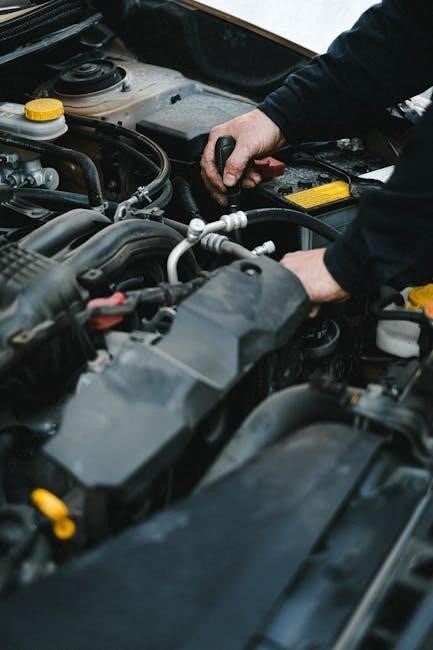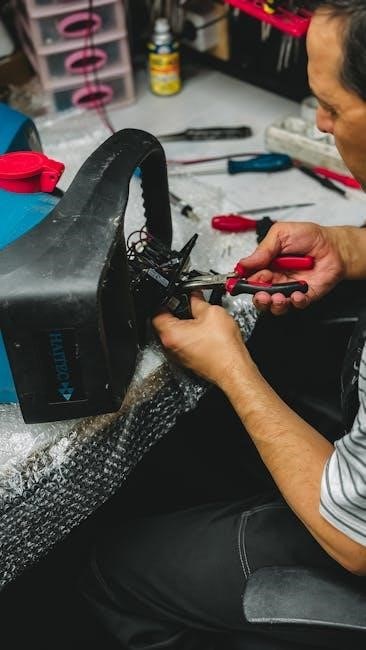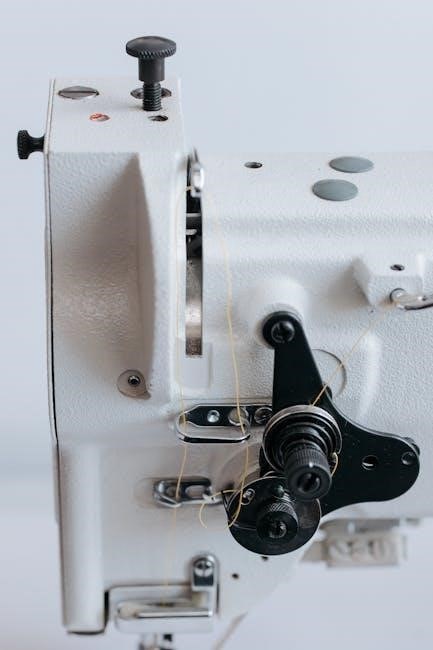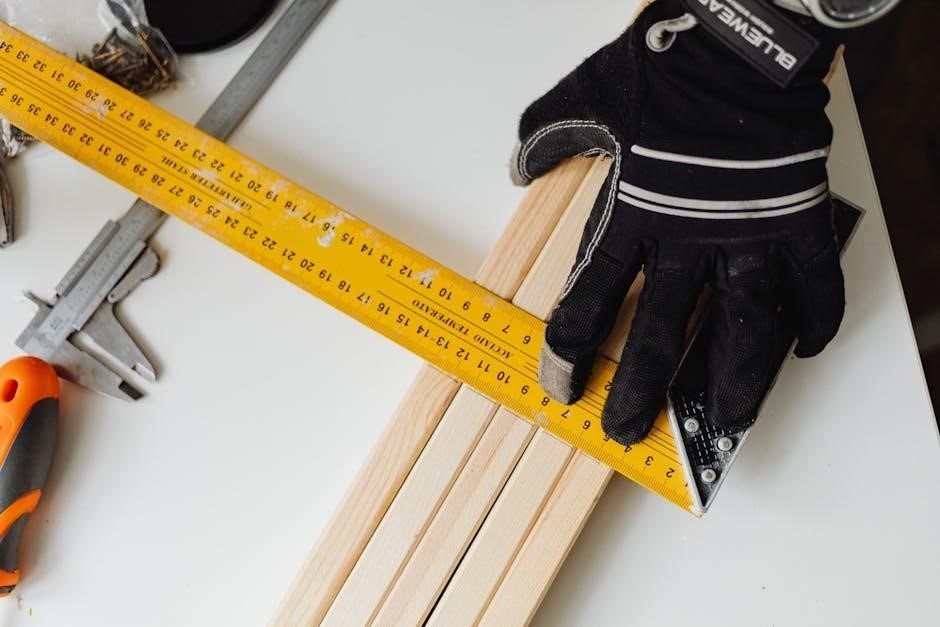
genie gs 1930 parts manual
Welcome to the Genie GS-1930 Parts Manual, your comprehensive guide for understanding, maintaining, and repairing your equipment. This manual provides detailed information, diagrams, and specifications to ensure proper operation and safety.
1.1 Overview of the Genie GS 1930
The Genie GS-1930 is a versatile and reliable scissor lift designed for construction, maintenance, and warehousing applications. It offers a maximum lift capacity and platform height, ensuring efficient operation in various environments. Known for its durability and ease of use, the GS-1930 features advanced safety mechanisms and intuitive controls. This equipment is built to withstand demanding conditions while providing stable and secure elevation solutions. Understanding its components and functionality is essential for optimal performance and longevity.
1.2 Importance of the Parts Manual
The Genie GS-1930 Parts Manual is an essential resource for maintaining, repairing, and understanding your equipment. It provides detailed diagrams, part numbers, and descriptions to help users identify and replace components efficiently. This manual ensures proper maintenance, reducing downtime and extending equipment lifespan. It also serves as a reference for troubleshooting and diagnosing issues, promoting safety and compliance with manufacturer standards. By following the guidelines in this manual, users can perform repairs accurately, ensuring the equipment operates at peak performance. Regular consultation of the manual helps prevent costly errors and ensures all parts are replaced correctly, maintaining the integrity and functionality of the Genie GS-1930.
1.3 Purpose of the Article
This article aims to provide a comprehensive guide to the Genie GS-1930 Parts Manual, helping users understand its structure, content, and application. It is designed to assist equipment operators, service technicians, and maintenance personnel in identifying parts, performing repairs, and ensuring compliance with safety standards. The article highlights key sections of the manual, such as diagrams, part numbers, and maintenance schedules, to facilitate efficient troubleshooting and component replacement. By following this guide, users can maximize the lifespan and performance of their Genie GS-1930 equipment while adhering to manufacturer recommendations and safety protocols; This resource is essential for anyone involved in the operation or maintenance of the Genie GS-1930.

Key Features of the Genie GS 1930
The purpose of this article is to provide a detailed overview of the Genie GS-1930 Parts Manual, ensuring users understand its content and application. It serves as a valuable resource for operators, service technicians, and maintenance personnel, offering guidance on part identification, maintenance schedules, and safety compliance. The article aims to enhance the user’s ability to troubleshoot, repair, and maintain the equipment effectively, ensuring optimal performance and longevity. By following the manual’s instructions, users can adhere to manufacturer recommendations and safety standards, ultimately prolonging the lifespan of their Genie GS-1930 equipment.
2.1 Design and Construction
The Genie GS-1930 is built with a focus on durability and reliability, featuring a robust steel construction designed to withstand rigorous use in various environments. Its compact design ensures maneuverability while maintaining stability, making it ideal for both indoor and outdoor applications. The equipment incorporates high-quality materials and advanced manufacturing techniques to ensure longevity and performance. The design emphasizes ease of maintenance, with accessible components and a user-friendly layout. Safety is integrated into every aspect of its construction, with features like secure access points and reinforced structural elements. This thoughtful design ensures the Genie GS-1930 remains a dependable choice for professionals seeking efficient and safe operation.
2.2 Technical Specifications
The Genie GS-1930 is equipped with a lift capacity of 500 lbs (227 kg) and a platform height of 19.3 feet (5.90 meters). It features a lightweight yet durable design, weighing approximately 2,400 lbs (1,089 kg), with dimensions of 4.4 feet (1.34 meters) in length and 3.4 feet (1.03 meters) in width. The machine operates on a 24V DC system, ensuring efficient performance and reliability. Its hydraulic system is designed for smooth operation, with a maximum pressure of 3,000 PSI. The unit is powered by a combination of battery and electric systems, making it suitable for both indoor and outdoor use. These specifications ensure optimal performance while maintaining safety and maneuverability in various work environments.
2.3 Safety Features
The Genie GS-1930 is designed with multiple safety features to ensure operator and equipment protection. It includes an emergency stop mechanism, load-sensing technology to prevent overload, and an automatic emergency descent system. The platform is equipped with non-slip surfaces and protective railings to prevent falls. Additionally, the machine features an alarm system for low battery or system malfunctions and emergency power shutdown capabilities. These safety measures are integrated to maintain reliable operation and minimize risks in various work environments. Regular maintenance, as outlined in the manual, further ensures the functionality of these safety features, providing a secure working experience for users.

Parts Identification
This section helps users recognize and locate components of the Genie GS-1930, using diagrams and naming conventions for easy identification, ensuring accurate maintenance and repairs.
3.1 Components Overview
The Genie GS-1930 consists of key components such as the boom, platform, control systems, and power unit. Additional parts include hydraulic cylinders, wire ropes, and electrical connections. Each component is designed for durability and safety, ensuring optimal performance. Understanding these parts is essential for proper maintenance and repairs. The manual provides detailed descriptions and diagrams to help users identify and locate each component efficiently. Familiarizing yourself with these components will enable you to troubleshoot and address issues effectively, ensuring the equipment operates at its best. This section serves as a foundation for further detailed exploration of the machine’s structure and functionality.
3.2 Diagrams and Schematics
The Genie GS-1930 Parts Manual includes detailed diagrams and schematics to help users visualize and understand the equipment’s structure. These visual aids are essential for identifying components, their locations, and relationships. Diagrams such as exploded views and hydraulic schematics provide a clear breakdown of assemblies, making it easier to disassemble and reassemble parts. Schematics highlight electrical and hydraulic systems, ensuring proper connections and flow. Cross-referenced with part numbers, these visuals guide users through maintenance, repairs, and replacements. They also help in identifying potential issues and planning repairs efficiently. By referring to these diagrams, users can ensure accurate and safe servicing of the Genie GS-1930, minimizing errors and downtime.
3.3 Naming Conventions for Parts
The Genie GS-1930 Parts Manual uses a standardized naming convention to ensure clarity and ease of identification. Parts are typically labeled with a combination of letters and numbers, such as “HYD-001” or “ELEC-012,” where the prefix denotes the category (e.g., HYD for hydraulic, ELEC for electrical). This system helps users quickly identify the function and location of each component. The manual also includes cross-references to diagrams and schematics, making it easier to locate and order replacement parts. Consistent naming ensures accuracy and prevents errors during maintenance or repairs. This structured approach is essential for efficient servicing and compliance with manufacturer standards.

Maintenance and Inspection
Regular maintenance is crucial for optimal performance and safety. The manual outlines schedules, inspection checklists, and tools needed to ensure the Genie GS-1930 operates efficiently and reliably.
4.1 Routine Maintenance Schedule
A well-structured routine maintenance schedule is essential for the Genie GS-1930. The manual provides a detailed timetable, outlining daily, weekly, and monthly checks. Operators should inspect hydraulic fluid levels, tire pressure, and battery condition daily. Weekly tasks include lubricating moving parts and checking for wear on wire ropes and chains. Monthly, ensure all safety systems are functioning correctly and perform a thorough inspection of the machine’s structural components. Adhering to this schedule helps prevent unexpected downtime, ensures operator safety, and extends the equipment’s lifespan. Regular maintenance also helps identify potential issues early, reducing costly repairs and optimizing performance.
4.2 Inspection Checklist
The Genie GS-1930 Parts Manual provides a detailed inspection checklist to ensure equipment reliability and safety. Key components to inspect include hydraulic systems, wire ropes, chains, and structural parts. Operators should check for wear, damage, or leaks in hydraulic hoses and cylinders. Wire ropes and chains must be examined for fraying or excessive wear. Structural components, such as boom sections and platforms, should be inspected for cracks or corrosion. Safety systems, including emergency stops and alarms, must be tested regularly. Control functions, like joystick operations and limit switches, should be verified for proper performance. A thorough inspection checklist helps identify potential issues early, ensuring safe operation and prolonging equipment lifespan.
4.3 Tools Required for Maintenance
Proper maintenance of the Genie GS-1930 requires a set of specialized tools to ensure safety and efficiency. Essential tools include wrenches, pliers, screwdrivers, and torque wrenches for tightening bolts and nuts. A multimeter may be needed for diagnosing electrical issues. Hydraulic pressure test kits are necessary for checking system integrity. Lubrication equipment, such as grease guns, is required for routine lubrication of moving parts. Additionally, safety tools like harnesses and hard hats should always be available. Ensure all tools are in good condition and calibrated properly. Refer to the parts manual for specific tool recommendations. Using the correct tools ensures compliance with safety standards and prevents equipment damage during maintenance procedures.

Troubleshooting Common Issues
Troubleshooting the Genie GS-1930 involves identifying common issues like hydraulic leaks or electrical malfunctions. Use diagnostic tools and the parts manual to pinpoint problems and resolve them efficiently.
5.1 Identifying Faulty Parts
Identifying faulty parts in the Genie GS-1930 requires a systematic approach. Start with a visual inspection to check for signs of wear, damage, or leakage. Use diagnostic tools to assess performance and compare findings with the specifications in the parts manual. Pay attention to components like hydraulic cylinders, pumps, and electrical systems, as these are common failure points. Cross-reference the manual’s diagrams and part numbers to ensure accurate identification. Proper identification is crucial to avoid replacing functional parts unnecessarily. Always consult the manual for guidelines on inspecting specific components and interpreting diagnostic results. This ensures efficient repair and minimizes downtime. Regular inspections can help catch issues early, preventing major failures. Accurate identification is key to maintaining equipment reliability and safety.
5.2 Diagnostic Procedures
Diagnostic procedures for the Genie GS-1930 involve a structured approach to identify issues. Begin with a visual inspection to spot visible damage or leaks. Use specialized tools like pressure gauges and multimeters to measure system performance. Refer to the parts manual for specifications and diagnostic flowcharts. Monitor error codes and system indicators for clues. Perform functional tests on hydraulic and electrical components to isolate faults. Always follow manufacturer guidelines to ensure safety and accuracy. Document findings for repair planning. Regular diagnostics help prevent unexpected downtime and ensure optimal equipment performance. By adhering to these steps, operators can quickly identify and address issues, maintaining productivity and safety.
5.3 Resolving Hydraulic System Issues
Resolving hydraulic system issues in the Genie GS-1930 requires a systematic approach. Begin by identifying symptoms such as leaks, low pressure, or erratic operation. Inspect hydraulic lines, cylinders, and pumps for damage or wear. Replace any faulty components using the parts manual for correct specifications. Check fluid levels and ensure the hydraulic oil meets manufacturer recommendations. Clean or replace filters to prevent contamination. Bleed the system to eliminate air pockets. Refer to diagnostic charts in the manual for troubleshooting guidance. Always follow safety protocols when working with hydraulic systems. Proper repair ensures optimal performance and prevents further damage. Regular maintenance can help avoid hydraulic-related issues altogether.

Parts Replacement Guidelines
Use genuine Genie parts for replacements to ensure compatibility and safety. Follow torque specifications and use proper tools. Adhere to safety guidelines during replacement to prevent equipment damage or injury. Always refer to the manual for detailed instructions and diagrams to guarantee correct installation and function. Proper replacement procedures maintain the integrity of your Genie GS-1930, ensuring optimal performance and longevity.
6.1 Steps for Replacing Wearable Parts
Replacing wearable parts on the Genie GS-1930 requires careful planning and adherence to safety protocols. Start by gathering the necessary tools and genuine Genie replacement parts. Ensure the machine is on level ground and all power sources are disconnected. Refer to the parts manual for specific instructions and diagrams. Remove the worn part by following the sequence outlined in the manual, taking care to document the removal process for reassembly. Inspect surrounding components for additional wear and address them if needed. Install the new part, ensuring proper alignment and torque specifications. Finally, test the machine to confirm proper operation and safety. Always follow safety guidelines to avoid injury or equipment damage.
6.2 Torque Specifications for Bolts and Nuts
Torque specifications for bolts and nuts on the Genie GS-1930 are critical for ensuring proper assembly and preventing damage. Always use a torque wrench to achieve the exact specifications outlined in the parts manual. Over-tightening or under-tightening can lead to equipment failure or safety hazards. Specifications vary depending on bolt size, material, and location, so consult the manual for precise values. For example, axle bolts may require higher torque than chassis fasteners. Ensure all bolts are tightened in the correct sequence to maintain structural integrity. Genie recommends using genuine parts to guarantee compatibility and safety. Proper torque adherence is essential for optimal performance and longevity of the machine.
6.3 Reassembly Procedures
Reassembly of the Genie GS-1930 requires careful attention to detail to ensure proper functionality and safety. Always reference the parts manual for specific instructions and torque specifications. Begin by cleaning all surfaces and applying a thin layer of grease to moving parts. Reattach components in the reverse order of disassembly, ensuring alignment and secure fastening. Use genuine Genie parts to maintain compatibility and performance. Tighten bolts and nuts in the recommended sequence to avoid uneven stress. Double-check all connections, hydraulic lines, and electrical systems before powering up the machine. Test the equipment under no load to confirm smooth operation; Adhere strictly to the manual’s guidelines to prevent damage and ensure operator safety.

Safety Precautions
Always follow safety guidelines when working with the Genie GS-1930 to prevent accidents. Ensure proper use of equipment, wear PPE, and adhere to operational safety protocols.
7.1 Personal Protective Equipment (PPE)
Using appropriate Personal Protective Equipment (PPE) is essential when working with the Genie GS-1930. Always wear safety glasses, a hard hat, and gloves to protect against hazards. Steel-toe boots are recommended to prevent foot injuries. Ensure all PPE fits properly and is in good condition. Hearing protection may be necessary in noisy environments. Regularly inspect PPE for damage or wear and replace as needed. Proper PPE use reduces the risk of injury and ensures compliance with safety standards. Always follow the manufacturer’s guidelines for PPE selection and maintenance. This ensures a safe working environment when handling or servicing the Genie GS-1930 equipment.
7.2 Safe Handling of Parts and Tools
Proper handling of parts and tools is crucial when working with the Genie GS-1930. Always lift heavy components with care, using mechanical aids if necessary, to avoid personal injury. Use tools specifically designed for the task to prevent damage to equipment or parts. Keep the workspace clean and well-organized to minimize tripping hazards and misplaced items. Clean and inspect parts before installation to ensure compatibility and functionality. Store tools and parts in designated areas to prevent loss or damage. Avoid using damaged or worn-out tools, as they can compromise safety and efficiency. Regularly inspect tools for wear and replace them as needed. Proper handling ensures safety and maintains the integrity of the equipment.

7.3 Emergency Procedures
In case of an emergency, immediately shut off the Genie GS-1930 and evacuate the area. Contact emergency services if necessary. For fires, use a fire extinguisher rated for electrical or hydraulic fires. Provide first aid if injuries occur and seek medical attention promptly. If a part malfunctions, do not attempt to operate the machine until it is repaired. Notify your supervisor or safety officer to ensure proper incident reporting. Keep emergency contact information readily available. Always prioritize personal safety and the safety of others. Familiarize yourself with emergency procedures before operating the equipment to respond effectively in critical situations. Proper emergency preparedness is essential for minimizing risks and ensuring a safe working environment.

Ordering Replacement Parts
To order replacement parts, identify the correct part numbers from the manual and contact Genie-approved suppliers or distributors. Follow the ordering process for timely delivery.
8.1 Identifying Part Numbers
Identifying the correct part numbers for your Genie GS-1930 is crucial for ordering replacements. Refer to the detailed diagrams and schematics in the parts manual, which list each component with its corresponding number. Cross-reference these numbers with the manufacturer’s catalog or approved suppliers to ensure accuracy. Part numbers are typically located near the component descriptions or in a dedicated index section. Double-checking these numbers before placing an order helps prevent errors and delays; Additionally, Genie provides an online lookup tool to verify part numbers, ensuring compatibility and correctness for your specific model. Always use the exact numbers provided in the manual or official resources;
8.2 Approved Suppliers and Distributors
When sourcing replacement parts for the Genie GS-1930, it is essential to use approved suppliers and distributors. Genie recommends purchasing parts directly from authorized dealers or official distributors to ensure quality and compatibility. These suppliers have access to genuine Genie parts and can provide accurate guidance. You can find a list of approved suppliers on Genie’s official website or through their customer support team. Always verify the supplier’s certification and reputation to avoid counterfeit or incompatible parts. Purchasing from unauthorized sources may void warranties or compromise safety. For international orders, check Genie’s global distribution network to locate a trusted supplier near you.
8.3 Ordering Process and Lead Times
To ensure a smooth parts replacement process, follow the structured ordering steps. Start by identifying the required part numbers from the manual. Next, contact an approved Genie supplier or use their online ordering portal. Provide clear details, including the equipment model and part numbers, to avoid delays. Orders can be placed via phone, email, or through Genie’s official website. Once confirmed, tracking information will be provided. Lead times vary depending on the part and location, typically ranging from 3 to 14 business days. For urgent needs, expedited shipping options are available at an additional cost. Always verify lead times with your supplier before placing an order.

Environmental and Compliance Considerations
Adhere to environmental regulations and safety standards when handling parts. Ensure proper disposal of hazardous materials and recycle components whenever possible to minimize ecological impact and promote sustainability.
9.1 Proper Disposal of Used Parts
Proper disposal of used parts from the Genie GS-1930 is crucial for environmental protection. Always adhere to local and international regulations regarding hazardous waste. Separate recyclable materials like metals and plastics from non-recyclable items. Use approved facilities for disposing of batteries, oils, and other hazardous substances. Ensure all parts are cleaned of fluids before disposal to prevent contamination. Consult local authorities or certified recycling centers for guidance. Proper disposal helps reduce environmental impact and ensures compliance with safety standards. Recycling eligible parts supports sustainability and reduces waste. Always follow manufacturer guidelines for eco-friendly practices when managing used components.
9.2 Compliance with Safety Standards
Compliance with safety standards is essential when working with the Genie GS-1930. Always adhere to international and local regulations, such as ISO and OSHA guidelines, to ensure safe operations. The parts manual outlines specific safety protocols for handling and replacing components. Use only approved tools and follow recommended procedures to minimize risks. Regular inspections and maintenance must align with industry standards to prevent accidents. Failure to comply can lead to operational hazards and legal consequences. By following safety standards, you ensure the reliability and efficiency of the equipment while protecting yourself and others. Always reference the manual for detailed compliance requirements.
9.4 Recycling Programs for Genie Parts
Genie promotes environmental responsibility through its recycling programs for parts. The Genie GS-1930 Parts Manual encourages users to participate in sustainable practices by returning used or obsolete components to authorized recycling centers. These programs aim to reduce waste and conserve resources by properly processing materials like metals, plastics, and hydraulics; Many Genie distributors offer designated drop-off locations or partnerships with recycling facilities. By recycling Genie parts, you contribute to a greener environment and comply with eco-friendly regulations. Always contact Genie customer support for details on local recycling options and guidelines. Recycling ensures the responsible disposal of equipment, aligning with global sustainability goals.
Related Posts

kenwood dmx7709s manual
Lost your Kenwood DMX7709S manual? Find a free, easy-to-use PDF guide here! Unlock all the features of your car stereo & hit the road happy. #Kenwood

neo g8 manual
Need help with your Neo G8? Find the official manual here! Troubleshooting, features, and everything you need for a smooth experience. Download your **Neo G8 manual** now!

ww scale manual
Need a WW scale manual? Quickly find instructions for any model at ShowLosAngeles! Download PDFs & troubleshoot issues – get weighing accurately now. #WWScale